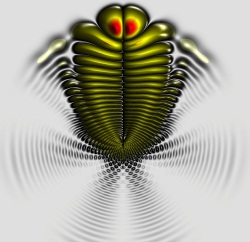Rewriting the rules for polar molecules
24 November 2011
A molecule containing two atoms of the same element can have a permanent electric dipole, say US scientists, contradicting the traditional view of molecular polarity.

The symmetry of the Rydberg molecule is broken by mixing with a 'trilobite' state, which gives the molecule a permanent dipole © Science/AAAS |
The traditional textbook view of polar molecules, explains Sadeghpour, is that a dipole arises from different elements having different electronegativity - the ability to draw electron density towards themselves in a bond. This means that heteronuclear molecules will be polarised towards the more electronegative atom. 'In homonuclear molecules the atoms are the same, so the charges do not separate and there is no permanent dipole,' he says. 'What we have shown, both in experiments and calculations, is that these molecules can have appreciable dipoles.'1
The dipole moment that the team measured is around 1 Debye. 'Very polar molecules such as sodium chloride [in the gas phase] have a dipole of around 10 Debye,' says Sadeghpour, 'but most polar molecules have dipoles in the order of 1-2 Debye.'
Over a decade ago, Sadeghpour was part of a team led by Chris Greene from the University of Colorado in Boulder, US, which predicted that certain kinds of homonuclear Rydberg molecules would have significantly distorted electron clouds and hence large permanent electric dipoles, of the order of thousands of Debye.2 They named these 'trilobite molecules' as their electron density maps resemble fossils of ancient sea creatures.
While no-one has yet made a trilobite molecule, a team from the University of Stuttgart in Germany succeeded in creating the first Rydberg molecules in 2009,3 but these were of a kind predicted to be spherically symmetric and hence not to have a dipole. However, Sadeghpour's group has now revisited these molecules and shown that there is a small contribution from the trilobite state to the overall electron distribution of the molecules. In other words, it can 'mix' into the spherically symmetrical state a little bit. This is what breaks the overall symmetry and gives the molecules their dipole.
This, for Greene, is the most intriguing result of the discovery. 'Not only is the trilobite state mixed into the [spherically symmetrical] s-state that's being observed in this work,' he says, 'but the reverse is also true that the s-state is mixed into the trilobite state.' He points out that this might provide an easier way to produce trilobite molecules, with their enormous dipoles, which would open up all sorts of interesting possibilities.
Phillip Broadwith
Broadwith, Philip. "Rewriting the rules for polar molecules". Royal Society of Chemistry. (24 Noviembre 2011). 26 Noviembre 2011. Disponible en: http://www.rsc.org/chemistryworld/News/2011/November/24111103.asp.
Maximiliano De La Higuera Macías
ID 141672.



No comments:
Post a Comment